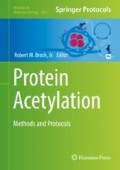Abstract
Histone acetylation plays important roles in regulating DNA metabolic processes, including many DNA repair pathways. The nucleotide excision repair (NER) pathway is critical for removing bulky, helix-distorting DNA lesions, such as UV light-induced photoproducts, but the activity of this pathway is significantly inhibited when lesions reside in nucleosomes. Recent studies have indicated that histone acetyltransferase (HAT) activity may be induced in response to UV damage, in order to facilitate the repair of UV-induced lesions in chromatin. Budding yeast (Saccharomyces cerevisiae) is an important model system for studying the functional roles of histone acetylation and HATs in NER, due to the ease of genetically altering HAT activity or acetylated lysine residues in histones. Here, we describe protocols for measuring the repair of cyclobutane pyrimidine dimers (CPDs), the major UV-induced photoproduct, in yeast strains deficient in HAT activity, either due to gene deletion or rapid anchor-away depletion of the HAT enzyme. Methods for measuring CPD repair in bulk chromatin, as well as individual chromatin loci, are detailed below.
Access this chapter
Tax calculation will be finalised at checkout
Purchases are for personal use only
References
Workman JL, Abmayr SM (2014) Fundamentals of chromatin. Springer, New York
Luger K, Mader AW, Richmond RK, Sargent DF, Richmond TJ (1997) Crystal structure of the nucleosome core particle at 2.8 A resolution. Nature 389:251–260
Rodriguez Y, Hinz JM, Smerdon MJ (2015) Accessing DNA damage in chromatin: preparing the chromatin landscape for base excision repair. DNA Repair 32:113–119
Mao P, Brown AJ, Malc EP, Mieczkowski PA, Smerdon MJ, Roberts SA et al (2017) Genome-wide maps of alkylation damage, repair, and mutagenesis in yeast reveal mechanisms of mutational heterogeneity. Genome Res 27:1674–1684
Mao P, Smerdon MJ, Roberts SA, Wyrick JJ (2016) Chromosomal landscape of UV damage formation and repair at single-nucleotide resolution. Proc Natl Acad Sci U S A 113:9057–9062
Nag R, Smerdon MJ (2009) Altering the chromatin landscape for nucleotide excision repair. Mutat Res 682:13–20
Lee KK, Workman JL (2007) Histone acetyltransferase complexes: one size doesn’t fit all. Nat Rev Mol Cell Biol 8:284–295
Mao P, Wyrick JJ (2016) Emerging roles for histone modifications in DNA excision repair. FEMS Yeast Res 16:fow090
House NC, Koch MR, Freudenreich CH (2014) Chromatin modifications and DNA repair: beyond double-strand breaks. Front Genet 5:296
Waters R, van Eijk P, Reed S (2015) Histone modification and chromatin remodeling during NER. DNA Repair 36:105–113
Friedberg EC, Walker GC, Siede W, Wood RD, Schultz RA, Ellenberger T (2006) DNA repair and mutagenesis, 2nd edn. ASM Press, Washington, DC
Hoeijmakers JH (2009) DNA damage, aging, and cancer. N Engl J Med 361:1475–1485
Spivak G, Hanawalt PC (2015) Photosensitive human syndromes. Mutat Res 776:24–30
Adar S, Hu J, Lieb JD, Sancar A (2016) Genome-wide kinetics of DNA excision repair in relation to chromatin state and mutagenesis. Proc Natl Acad Sci U S A 113:E2124–E2133
Hodges AJ, Gallegos IJ, Laughery MF, Meas R, Tran L, Wyrick JJ (2015) Histone sprocket arginine residues are important for gene expression, DNA repair, and cell viability in Saccharomyces cerevisiae. Genetics 200:795–806
Lloyd RS (1999) The initiation of DNA base excision repair of dipyrimidine photoproducts. Prog Nucleic Acid Res Mol Biol 62:155–175
Sutherland BM, Shih AG (1983) Quantitation of pyrimidine dimer contents of nonradioactive deoxyribonucleic acid by electrophoresis in alkaline agarose gels. Biochemistry 22:745–749
Bespalov VA, Conconi A, Zhang X, Fahy D, Smerdon MJ (2001) Improved method for measuring the ensemble average of strand breaks in genomic DNA. Environ Mol Mutagen 38:166–174
Bohr VA, Smith CA, Okumoto DS, Hanawalt PC (1985) DNA repair in an active gene: removal of pyrimidine dimers from the DHFR gene of CHO cells is much more efficient than in the genome overall. Cell 40:359–369
Gong F, Fahy D, Smerdon MJ (2006) Rad4-Rad23 interaction with SWI/SNF links ATP-dependent chromatin remodeling with nucleotide excision repair. Nat Struct Mol Biol 13:902–907
Nag R, Kyriss M, Smerdon JW, Wyrick JJ, Smerdon MJ (2010) A cassette of N-terminal amino acids of histone H2B are required for efficient cell survival, DNA repair and Swi/Snf binding in UV irradiated yeast. Nucleic Acids Res 38:1450–1460
Chaudhuri S, Wyrick JJ, Smerdon MJ (2009) Histone H3 Lys79 methylation is required for efficient nucleotide excision repair in a silenced locus of Saccharomyces cerevisiae. Nucleic Acids Res 37:1690–1700
Kou H, Zhou Y, Gorospe RM, Wang Z (2008) Mms19 protein functions in nucleotide excision repair by sustaining an adequate cellular concentration of the TFIIH component Rad3. Proc Natl Acad Sci U S A 105:15714–15719
Haruki H, Nishikawa J, Laemmli UK (2008) The anchor-away technique: rapid, conditional establishment of yeast mutant phenotypes. Mol Cell 31:925–932
Southern EM (1979) Measurement of DNA length by gel electrophoresis. Anal Biochem 100:319–323
Bohr VA, Okumoto DS (1988) Analysis of frequency of pyrimidine dimers in specific genomic sequences. In: Friedberg EC, Hanawalt PC (eds) DNA repair: a laboratory manual of research procedures, vol 3. Marcel Dekker Inc., New York, pp 347–366
Acknowledgments
We thank Dr. Michael Smerdon, Dr. Peng Mao, and Dalton Plummer for helpful comments and suggestions. This research was supported by grants from NIEHS (R01ES002614 and R21ES027937).
Author information
Authors and Affiliations
Corresponding author
Editor information
Editors and Affiliations
Rights and permissions
Copyright information
© 2019 Springer Science+Business Media, LLC, part of Springer Nature
About this protocol
Cite this protocol
Hodges, A.J., Roberts, S.A., Wyrick, J.J. (2019). Using Yeast as a Model Organism to Study the Functional Roles of Histone Acetylation in DNA Excision Repair. In: Brosh, Jr., R. (eds) Protein Acetylation. Methods in Molecular Biology, vol 1983. Humana, New York, NY. https://doi.org/10.1007/978-1-4939-9434-2_10
Download citation
DOI: https://doi.org/10.1007/978-1-4939-9434-2_10
Published:
Publisher Name: Humana, New York, NY
Print ISBN: 978-1-4939-9433-5
Online ISBN: 978-1-4939-9434-2
eBook Packages: Springer Protocols

